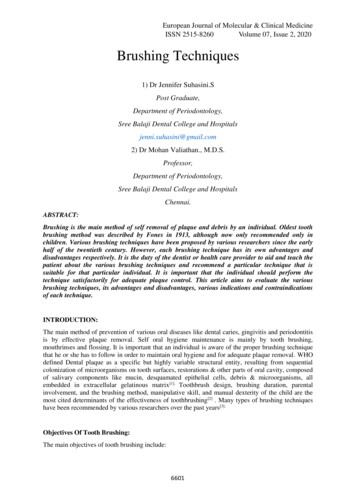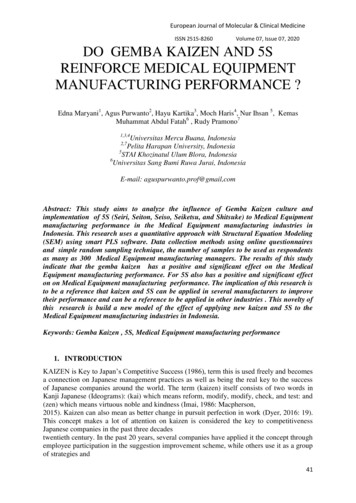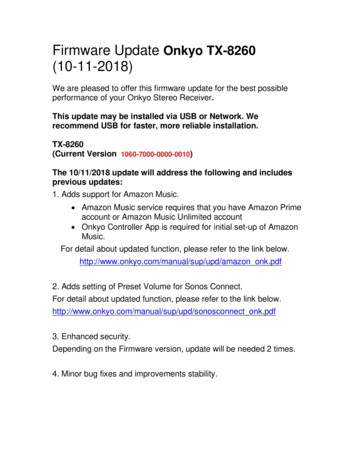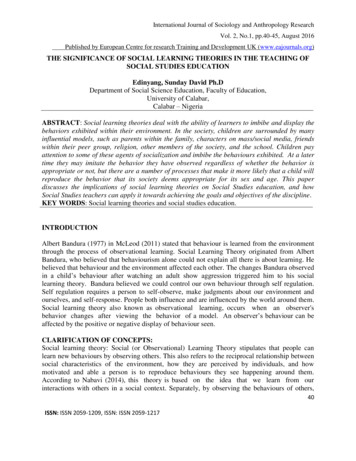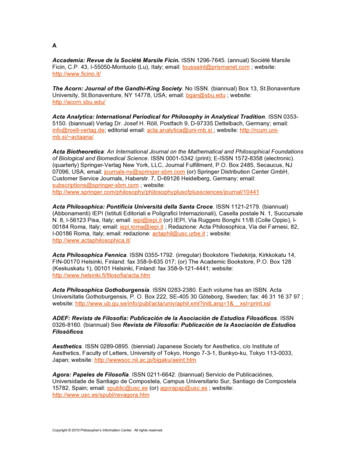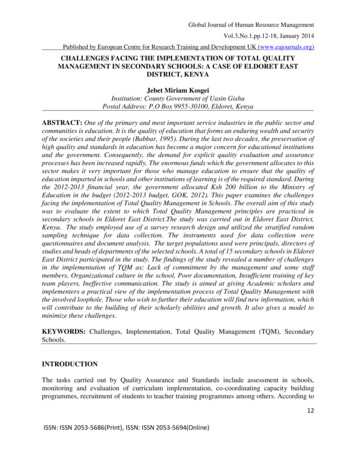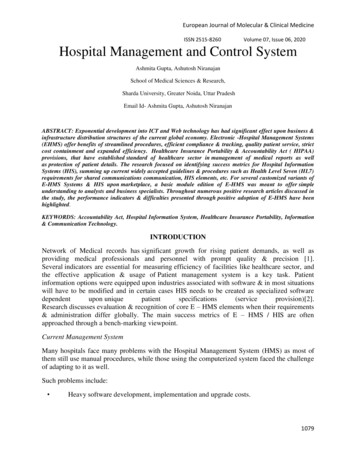
Transcription
European Journal of Molecular & Clinical MedicineISSN 2515-8260Volume 07, Issue 06, 2020Hospital Management and Control SystemAshmita Gupta, Ashutosh NiranajanSchool of Medical Sciences & Research,Sharda University, Greater Noida, Uttar PradeshEmail Id- Ashmita Gupta, Ashutosh NiranajanABSTRACT: Exponential development into ICT and Web technology has had significant effect upon business &infrastructure distribution structures of the current global economy. Electronic -Hospital Management Systems(EHMS) offer benefits of streamlined procedures, efficient compliance & tracking, quality patient service, strictcost containment and expanded efficiency. Healthcare Insurance Portability & Accountability Act ( HIPAA)provisions, that have established standard of healthcare sector in management of medical reports as wellas protection of patient details. The research focused on identifying success metrics for Hospital InformationSystems (HIS), summing up current widely accepted guidelines & procedures such as Health Level Seven (HL7)requirements for shared communications communication, HIS elements, etc. For several customized variants ofE-HMS Systems & HIS upon marketplace, a basic module edition of E-HMS was meant to offer simpleunderstanding to analysts and business specialists. Throughout numerous positive research articles discussed inthe study, the performance indicators & difficulties presented through positive adoption of E-HMS have beenhighlighted.KEYWORDS: Accountability Act, Hospital Information System, Healthcare Insurance Portability, Information& Communication Technology.INTRODUCTIONNetwork of Medical records has significant growth for rising patient demands, as well asproviding medical professionals and personnel with prompt quality & precision [1].Several indicators are essential for measuring efficiency of facilities like healthcare sector, andthe effective application & usage of Patient management system is a key task. Patientinformation options were equipped upon industries associated with software & in most situationswill have to be modified and in certain cases HIS needs to be created as specialized softwaredependentupon esearch discusses evaluation & recognition of core E – HMS elements when their requirements& administration differ globally. The main success metrics of E – HMS / HIS are oftenapproached through a bench-marking viewpoint.Current Management SystemMany hospitals face many problems with the Hospital Management System (HMS) as most ofthem still use manual procedures, while those using the computerized system faced the challengeof adapting to it as well.Such problems include: Heavy software development, implementation and upgrade costs.1079
European Journal of Molecular & Clinical MedicineISSN 2515-8260 Volume 07, Issue 06, 2020Difficulty switching from manual processes because both the staff and patients areaccustomed to manual processes and are therefore unable to deal with the new methodquickly.There are also some problems posed by the lack of IT compliant medical personnel.Large influx of the patients visiting government hospitals makes it extremely difficultto switch to automated processes. They don't have the patience to wait for theregistration and data entry, and sometimes struggle to understand automated processesworking.Considering this, there is a need to develop the computerized HMS for these hospitals as it willhelp to provide for and for customize clinical data, enable ready-made models to be diagnosedmore easily, encourage doctors to follow advanced medical prescription patterns, etc.Hospital Management System (HMS)Management was described as the method, comprising social and technical functions andpractices that occur within organizations in order to achieve predetermined goals throughhumans and the other resources. Quality in healthcare and patient protection are the universalmotto of both primary and secondary care providers. For hospitals a number of models andschemes have been implemented over the years for patient interventions and growth. Strategiesof managing medical activities delivers benefits of streamlined operations, strengthenedgovernance & supervision, excellent patient treatment, strict cost containment & increasedefficiency. There are diverse modules in process of the HMS.These include: Patient management,Appointment scheduling,Store management,Services management,Pharmacy managementPatient information systems are in high demand for coping with rising population demands, aswell as helping physicians & Medical care & supporting members for care & accuracy. Variousindicators are available to measure the efficiency of facilities such as hospital business, and a keyaspect is the effective adoption as well as use of the techniques of IS of Medical care. In thesoftware industry, hospital information systems are available that need to be customized in manyother cases, & HIS has to be developed in some situations as a personalized program focusedupon specific medical criteria (service provision). Research discusses the evaluation andrecognition of core elements[2]–[12].The current system applies to the system being practiced up to now. Actually all functionalitiesof hospital are performed manually. This is, if a patient wants to see a doctor, he will be forced tosee his doctor before he has called his opportunity. That's making the person really hard. Ticketsare sold directly to outpatients and hospital patients. The primary downside is time consuming.Limitations of existing system: Shortage of security of data.1080
European Journal of Molecular & Clinical MedicineISSN 2515-8260 Volume 07, Issue 06, 2020Time consuming.Manual work.Consumes huge volume of the paper work.The higher officials have no direct involvement.To avoid all these limitations, and to make the system operate more efficiently,computerization is necessary.Objective To determine the key performance standard and indicators Hospital Information Systems(HIS) & E - Hospital Management (E –HMS).To determine E-Hospital Administration Software Core Components.Requirement of HIS & E-HMSEmergency and regular hospital services are required & role of HIS in this is critical. Medicalprovisions were sensitive to customers & community, as well as quality of HIS & hospital staffprovision must be accurate and of the highest standard[7]. Given low-cost pressure from publicsector hospitals, today's hi-tech healthcare facilities are increasingly provided at higher ratesthrough private players over marketing sector. OECD study (2013) recognizes which attempt toreduce prices by administrative methods, like lowering rates for medical care & rationingcoverage for patients, had generally been just marginally effective. E-HMS guarantees benefitsof smooth processes, improved management & monitoring, excellent medical treatment, tightregulation of expenses & enhanced income[13]. Due to the demands that are legal & industrialsector such as U.S. Healthcare Insurance Portability and Accountability Act (HIPAA) as a globalhealthcare organization, the urgent need to integrate their businesses is fully realized.Unfortunately, most patient IS remained confidential & therefore only serve single agencywithin medical sector. That is major barrier for market cooperation[14].E-HMS is developed for meeting broad Medical care management network as well as procedurefor multi-specialty hospitals. This is incorporated end-to-end HMS that offers relevant hospitalwide information to support efficient decision-making in such a seamless flow within medicalpractices, managing the medical activities & crucial management of finance sector in medicalcare. Table 1 illustrates many of the main characteristics of this NIC, India e-Hospital solution.Table 1: E – Hospital Management Solution Distinct Features1081
European Journal of Molecular & Clinical MedicineISSN 2515-8260Volume 07, Issue 06, 2020MODEL OF HOSPITAL INFORMATION SYSTEMThe most important tasks can be summarized as follows about HMS: 1. Storing & recording the status of patients While in case of abnormal examination findings & several similar crucialinformation, visual & auditory warning systems are generated.Information Collection & predictive analysis for research-oriented uses.Due process ranges & evaluation times to be allocated for patient evaluations.The medical record of the patient is electronically stored accurately[15] (e.g. drugallergies) are provided.1. Management and Data Flow Enable graphical or digitized hospital database diagnostic images based on theintegrated recovery system.Registration of human resources and their properties.Support for automatic transfer of Interdepartmental & clinical medical info.For the online production of internal orders, digital signatures used.Communicating by laboratory information system.2. Financial Aspects Use and monitoring of medicinal products and ordering process are effective.Computerized portrayal of healthcare provider 's needs.Effective finance administration.Actual and expected treatment costs are listed and reported.State assessment of bed utilization & whole medical data output.1082
European Journal of Molecular & Clinical MedicineISSN 2515-8260Volume 07, Issue 06, 2020E-HMS [16] was developed Which address a broad spectrum of hospital operations and superspecialty patient management procedures. This is an important, end-to - end HMS that deliversappropriate facility-wide knowledge to help effective decision-making within constant processfor patient treatment, Medical care management & essential corporate finance.SUMMARYThis indicates 5 separate styles of hospitals as per WHO's Medical Proof Study qualityassessment as follows:a.b.c.d.e.Surveys of consumer’s experiencesRegulatory inspectionStatistical indicatorsInternal assessments.Third-party assessmentsIn addition, centered over following research scenarios and numerous E Hospital AdministrationStrategies conversations [6] & HIS, multiple elements of E-Hospital Administration approachwere listed below to facilitate potential researchers and industry experts understanding.1. HMS/HIS basic model:i.Patient enrollment & consultation preparation software - An automated patient careprogram was Compliance feature that gathers patient information that is accurate andappropriate[17]. The program automates the roles of hospital management for a betterand more efficient method of patient care.ii.Unit Patient Billing and Benefits - Billing system of patient deals with all aspects of longterm care billing. This system supports cashier and billing operations for various patientgroups such as ambulance, clinic & reference. It offers automated uploading of chargesalluded to different facilities like bed charges, lab studies conducted, medications given,payments for consultants, food , telephone as well as beverage charges [18]. Thisframework offers limited payment billing which could be fully combined with financemanagement Application.iii.Services Module- This offers effective management of all the services at the hospital andsecure entry and handling of the charges for each of these services.iv.Outpatient Care Program- Out-patient interface acts as a point of entry to arrange aprofessional examination & testing appointment with a local doctor / consulting doctor[19]. This module supports doctors through offering an opportunity to acquire medicalrecords of patient instantly to make better and timely consultation decisions.v.User Management Module - The User Manager Module basically deals with security bycontrolling access to the system details. Every computer that is connected to a user groupmay monitor only certain displays upon which user group has rights. This also trades insystem-related tasks like user management, user manager, user community leader1083
European Journal of Molecular & Clinical MedicineISSN 2515-8260Volume 07, Issue 06, 2020development & viewing employee database company document maintenance, user grouplookup, generating daily statistical summary and user-defined error message.2. HMS/HIS- Optional Modeli.Pharmacy Mod- Pharmacy app is associated with automating the general operation andmaintenance phase of a drugstore. The pharmacy machine incorporates bar-codingtechnology, that transforms it more convenient to supply medical items to the patient.ii.Radiology Managing Mod- This offers provision like Ultra sound, X-ray, scanning andalike. This services can be arranged[20]. The program stores all the specifics of differenttest results and produces records based on outcomes of examination.iii.Electronic Medical Record (EMR) – This was termed as completely collaborated datastorage which provides patient records in the hospital for medical and clinical records.Staffs of Health-care sector from different hospital sections with relevant information suchas medical exams, diagnoses, history of treatment, test results, etc. The platform offers amedium to reach to critical & accurate medical record of patient leading reliable medicaltreatment of high quality and low cost.iv.Lab Management Mod - Lab required for a particular examination report and theprocedure included in presenting findings to appropriate hospital unit / doctor. L absection starts with accepting electronic inquiries from clinicians and often supports labworkers in creating inquiries. Lab unit facilitates various researches in the followingdisciplines: Cytology, Serology, Biochemistry, Microbiology, Hematology, Radiology andNeurology.v.Emergency Management- Emergency module in HMS software enables patients to beregistered quickly by capturing Main & precise specifics of identification, includingstatistical profile, especially considering that this feature is important. Present unit alsogathers details about Medico Legal Cases (MLC), and is being utilized for referring publicbodies.vi.Blood Bank- This module is quite comprehensive in its nature in the E-HMS which keepsall information about blood donation. The donor and recipient information are preserved.vii.MIS Interface - The interface shown in HMS program was collection of core principlesand requirements for all aspects of hospital which were typically checked regularly byhigher leadership.CONCLUSIONThe numerous success metrics and criteria of the E – hospital management system & HIS wereaddressed in corresponding segment & cases. E – HMS / HIS performance indicators appear todiffer based on leadership resources, preparation, technological acceptance, user acceptance, etc.HIPAA Privacy Guidelines & HL7 / RIM system are defined in form of key determinants &global regulatory benchmarks for production & deployment of effective patient management1084
European Journal of Molecular & Clinical MedicineISSN 2515-8260Volume 07, Issue 06, 2020strategies. Specific case studies on wider E – Hospital Management Approach / HIS frameworkalso pave the way for future E–Hospital Management Enhancement research.REFERENCES[1]MSH (Management Sciences for Health), Health Systems in Action.An ehandbook for Leaders and Managers. 2010.[2]F. Sultan et al., “Development of an in-house hospital information system in a hospital in Pakistan,” Int. J. Med. Inform.,2014.[3]A. Guérin, P. Mirbod, N. Curatolo, A. Rieutord, and A. Sinclair, “Quality management system,” J. Pharm. Clin., 2016.[4]K. M. Cresswell, A. Worth, and A. Sheikh, “Integration of a nationally procured electronic health record system intouser work practices,” BMC Med. Inform. Decis. Mak., 2012.[5]P. W. Handayani, A. N. Hidayanto, A. A. Pinem, I. C. Hapsari, P. I. Sandhyaduhita, and I. Budi, “Acceptance model ofa Hospital Information System,” Int. J. Med. Inform., 2017.[6]S. . Asabe and N. . Oye, “Hospital Patient Database Management System,” Int. J. Adv. Comput. Technol., 2013.[7]J. I. Westbrook et al., “Cost-effectiveness analysis of a hospital electronic medication management system,” J. Am. Med.Informatics Assoc., 2015.[8]M. Mimee et al., “An ingestible bacterial-electronic system to monitor gastrointestinal health,” Science (80-. )., 2018.[9]D. H. Gadhari, Y. P. Kadam, and P. P. Suman, “Hospital Management System,” Int. J. Res. Eng. Appl. Manag., 2016.[10]D. Queiruga, J. González Benito, and G. Lannelongue, “Evolution of the electronic waste management system inSpain,” J. Clean. Prod., 2012.[11]A. Dubovitskaya, Z. Xu, S. Ryu, M. Schumacher, and F. Wang, “Secure and Trustable Electronic Medical RecordsSharing using Blockchain,” AMIA . Annu. Symp. proceedings. AMIA Symp., 2017.[12]P. Balaraman and K. Kosalram, “E –Hospital Management & Hospital Information Systems – Changing Trends,” Int. J.Inf. Eng. Electron. Bus., 2013.[13]N. Menachemi and T. H. Collum, “Benefits and drawbacks of electronic health record systems,” Risk Manag. Healthc.Policy, 2011.[14]S. Y. Hung, W. H. Hung, C. A. Tsai, and S. C. Jiang, “Critical factors of hospital adoption on CRM system:Organizational and information system perspectives,” Decis. Support Syst., 2010.[15]D. D. Ratnaningtyas and K. Surendro, “Information Quality Improvement Model on Hospital Information System UsingSix Sigma,” Procedia Technol., 2013.[16]J. V. Carvalho, Á. Rocha, R. van de Wetering, and A. Abreu, “A Maturity model for hospital information systems,” J.Bus. Res., 2019.[17]E. D. Zepeda, G. N. Nyaga, and G. J. Young, “Supply chain risk management and hospital inventory: Effects of systemaffiliation,” J. Oper. Manag., 2016.[18]S. Sulaiman, A. A. K. Abdul Hamid, and N. A. Najihah Yusri, “Development of a Blood Bank Management System,”Procedia - Soc. Behav. Sci., 2015.[19]C. Ullrich, F. Van Utterbeeck, E. Dejardin, M. Debacker, and E. Dhondt, “Pre-hospital simulation model for medicaldisaster management,” in Proceedings of the 2013 Winter Simulation Conference - Simulation: Making Decisions in aComplex World, WSC 2013, 2013, pp. 2432–2443.[20]J. W. Nance, C. Meenan, and P. G. Nagy, “The Future of the radiology information system,” American Journal ofRoentgenology. 2013.1085
To determine the key performance standard and indicators Hospital Information Systems (HIS) & E - Hospital Management (E -HMS). To determine E-Hospital Administration Software Core Components. Requirement of HIS & E-HMS Emergency and regular hospital services are required & role of HIS in this is critical. Medical provisions were sensitive to customers & community, as well as quality of HIS .
